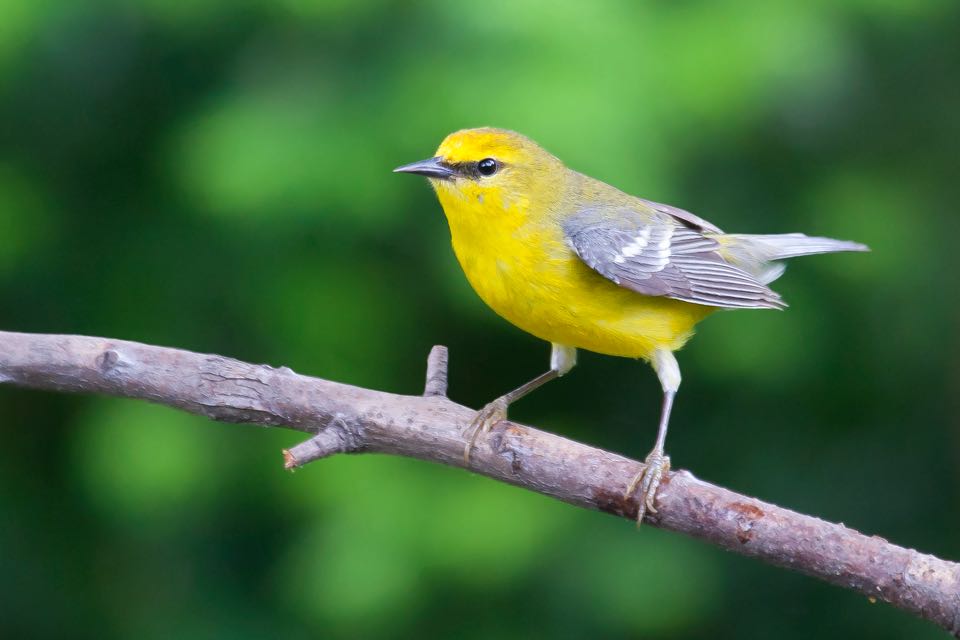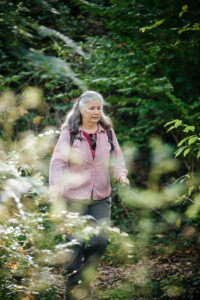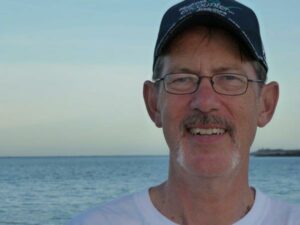By Eric Wallace

Blue-winged Warbler (CO Bob Schamerhorn)
This past spring, things were looking grim for the second Virginia Breeding Bird Atlas: COVID-19 was rampaging across the U.S. and stay-at-home orders had shut down the state. The five-year-long study was entering its final season and relied on the efforts of citizen scientists.
If volunteer birders couldn’t conduct surveys, how would the project move forward?
“To succeed, we need to gather comprehensive data for avian population density and breeding activity throughout the state,” says project coordinator Dr. Ashley Peele, an avian ecologist at Virginia Tech’s Conservation Management Institute. The information will enable her and other scientists—including peers from sponsoring agency, the Virginia Department of Wildlife Resources, and partner organizations like the Smithsonian Conservation Biology Institute at Front Royal, and more—to study changes that have occurred since the first Virginia Breeding Bird Atlas was completed in 1989. It will also help them evaluate existing avian conservation strategies and adjust priorities moving forward.
Circa mid-March, it seemed four years of hard work would almost certainly be capped by a highly limited fifth season. If that happened, a number of key areas of the state were likely to go un-surveyed.
Then came a welcome surprise. Refusing to accept failure, many volunteers doubled down. (Take, for example, Bedford’s Bob Epperson.) Or the dedicated group of regional coordinators and volunteer blockbusters who have spent the last two months coordinating strategic survey efforts around the state. They found ways to safely atlas in under-birded remote areas and/or complete priority blocks close to home.
By mid-June, VABBA2 volunteers have logged more than 12,000 field-hours in 2020. That’s impressive, considering annual mean hours for 2016-2019 total about 14,000 per year.

2020 Atlas Volunteer Effort (as of 6/27/20)
Beyond the volume of data being collected, volunteers have fine-tuned where they are birding, focusing on the ‘neediest’ areas with the help of priority block target maps and guidance provided by Dr. Peele. Compare where volunteers have spent their Atlas birding time in 2020 (map shown above) with the initial target areas set by the project at the start of this year (map shown below) and it is easy to see why 2020 has already been a success.

VABBA2 Priority Block Targets at the start of 2020
“I continue to be astounded by the dedication of our volunteers,” says Peele. “What we’ve been able to accomplish is incredible. The project has already been a success, but if we keep this up through July, we will end this project on an incredibly high note.”
But that’s not the only good news. Putting in extra hours has brought volunteers treasure troves of new discoveries. Below, two offer thoughts about upping the ante—and share some of their favorite atlasing adventures.
—
JoAnn Dalley, Charlottesville— A mother of three adult children, JoAnn has lived in the Charlottesville area with her husband, David, for nearly 40 years and is recently retired. She’s traveled the world visiting fantastic nature spots, section hiked most of the Virginia segment of Appalachian Trail, served as a local Girl Scout leader, and regularly volunteers with conservation-minded groups like the Charlottesville Area Tree Stewards and Rivanna Master Naturalists.
When did you start atlasing for the VABBA2 and why?
Put simply, I’m retired and love wandering in nature. Plus, atlasing is a way to be of service to what I view as a crucial citizen science initiative.
It began shortly after I started birding about five years ago. (The bird bug bit me hard and I’ve since taken Dan Bieker’s Piedmont Virginia Community College Field Ornithology Class three times.) Before that, I was more of a master naturalist and generalist. I noticed birds and could identify some, but I didn’t focus on them to a great degree.
I heard about the VABBA2 in 2017 while attending Monticello Bird Club meetings. I learned more while taking [Bieker’s ornithology] class for the second time. I started contributing [to the project’s eBird database] early that spring—my first observation was a wild turkey I saw near our home in Madison County, which happens to be located in a priority block.
Back then, I barely knew what I was doing and was nervous about making mistakes. But I saw the project as a way to educate myself about avian behavior and grow my birding skills. A turning point came later in 2017, when I spotted a Grasshopper Sparrow—one of my Life Birds—while atlasing in Troutville.
By 2018, I was enjoying myself so much I decided to take a VABBA2 training course in April, while I was visiting my mother’s home on the Northern Neck. There, I saw several different species of warbler. That was such an amazing experience. Though I still had a lot to learn about birds and their behaviors, I became extremely invested in the project.
Name a few of your favorite VABBA2 experiences to date?

JoAnn Dalley hiking in the Shenandoah National Park (CO Eze Amos)
I’ve participated in two rallies—which were so much fun, especially the full event from last year! I also birded extensively in five priority blocks along the U.S. Route 76 TransAmerica Bicycle Trail while supporting my husband, who was riding of the western half of its Virginia section. That let me see a lot of the state and explore interesting habitats from Afton Mountain to the Kentucky border.
You’ve recently been working hard to complete more priority blocks. Tell us about some of those efforts?
David and I have worked on several priority blocks on the Northern Neck in the past couple of years. This spring, I took on a pair of blocks in highly rural areas located within driving distance of our family’s second home in Kilmarnock.
As mentioned above, David and I own a 30-acre property in Madison County that’s more than 80 percent forested and sits in a priority block. I started there, then began working with Guy Babineau and Ashley Peele to target other blocks in the county, as well as some in rural Albemarle, Orange, Campbell and Bedford counties.
What’s the most interesting thing you’ve seen so far in 2020?
I’ve gotten to see so many great things, it’s impossible to pick just one!
For instance, my husband and I recently revisited an Osprey nest we spotted on top of a silo late last year. This year, we found an adult with a chick in the nest, which upgraded [our prior breeding code entry] from ‘Used Nest’ to ‘Nest with Young.’ It didn’t matter that the block already had an Osprey confirmed, it was just really cool.
A few days later, a Mississippi Kite flew over our heads while we were standing on a church property next to a young clear-cut, regrowth area. That was awesome!
—
John Pancake, Goshen Pass— A retired journalist that spent 40 years writing and editing for outlets like the Roanoke Times, Miami Herald and Washington Post. He’s been birding in Virginia since 1971.

John Pancake
When did you begin working with the VABBA2 and why?
I started five years ago, when the project launched. So many of the state’s finest birders—including J.J. Murray, Fred Scott, Mo Stevens, Jerry Via, Ned Brinkley, YuLee Larner, Bob Ake, Myriam Moore and Barry Kinzie—have shared their knowledge with me over the years that it felt like I should follow their example and try to help the next generation understand our birds.
My hearing is still fairly sharp and my legs will carry me to the top of a mountain. So, I’ve put aside a lot of other birding plans to do this. It’s important. The records we end up with should be preserved in Cornell’s database for scientists and birders to use a century from now.
What areas have you focused on?
I live in Rockbridge County near Goshen Pass, which is a mountainous and fairly remote area. I started with nearby blocks and gradually worked my way into Bath, Botetourt, Alleghany and Augusta counties.
You’ve recently been working to complete more priority blocks. Tell us about some of those efforts?
Dr. Ashley Peele has done such an amazing job getting us so close to the finish line—and now she’s been blindsided by the pandemic. It’s made her job 1,000 percent harder.
For instance, I’d intended to make some week-long forays to areas where she needed help, but the threat of the virus changed my plans. Instead, I’ve been concentrating on finishing up blocks within a 90-minute drive of my home.
Early in the spring, my very patient wife accompanied me on an all-night owling rampage through some blocks that were nearly complete but needed an hour or so of nocturnal birding. We got lost a couple times, but eventually found a few owls.
Since then, I’ve been working on polishing off six or seven blocks that were partly done but needed a final push. That’s typically entailed hours of “slow birding”—moving patiently through the woods and fields to pick up a Song Sparrow carrying food, a swallow nesting in an old barn, an oriole visiting a nest, a Warbling Vireo feeding young, a Killdeer feigning a broken wing to lure you away from its nest, and so on.
Past Atlasing highlights?
Birding on Paddy Knob in 2017 was a big one. With an elevation of 4,477 feet, it’s one of the highest mountains in Virginia and home to a rare breeding population of Mourning Warblers— beautiful but skulking birds that lurk in blackberry brambles. The mountain is in Bath and Highland County, right on the West Virginia line. It was a thrill to get up there early and hear them singing.
I also birded on Garden Mountain in Botetourt County last summer with my friend, Bob Epperson. We found a brushy area under a huge powerline where a Blue-winged Warbler was singing. Being uncommon, that species is of special interest, and we were determined to confirm that the birds were breeding there. It wasn’t easy. It took us hours of patient watching before we finally saw a female pop up in a bush with a caterpillar in her beak and zip down to a likely nest spot.
Coolest thing you’ve seen in 2020 so far?
One evening I went up to an area off Deerfield Road in Bath County at dusk. I hiked a forest service road for a while and then went back to some fields on the edge of the woods. The stars came out, the moon rose and a Whip-poor-will began to call. Then another and another, until I was surrounded by at least seven birds filling the night with their cries. It was a magical moment.
At a cattail marsh north of Goshen, in Rockbridge County, I listened to two Virginia Rail giving their weird calls—an accelerating series of grunts. Allen Larner of Staunton had detected them a week earlier and their continued presence suggests they are probably breeding there. I’ve been birding in Rockbridge County most of my adult life, but had never found breeding rails here. How exciting!

